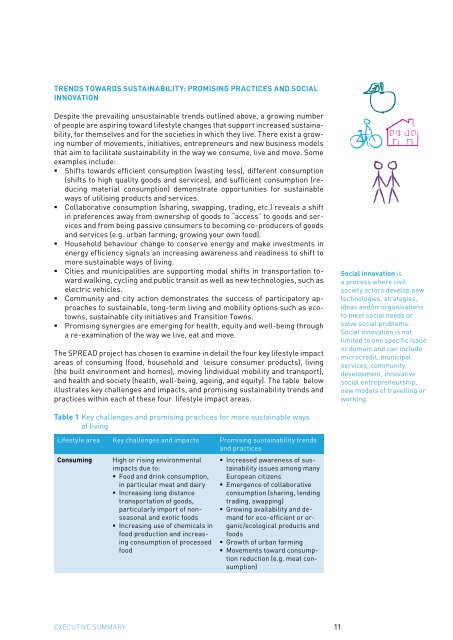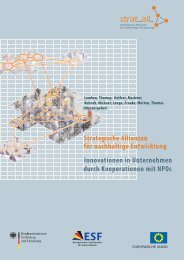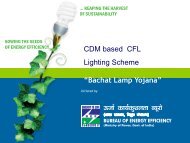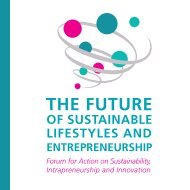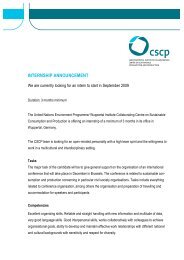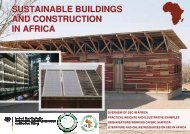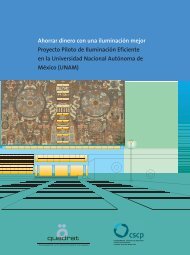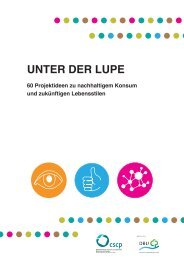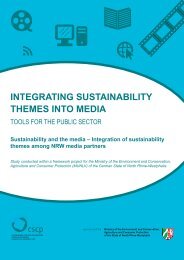today's facts & tomorrow's trends - SPREAD Sustainable Lifestyles ...
today's facts & tomorrow's trends - SPREAD Sustainable Lifestyles ...
today's facts & tomorrow's trends - SPREAD Sustainable Lifestyles ...
You also want an ePaper? Increase the reach of your titles
YUMPU automatically turns print PDFs into web optimized ePapers that Google loves.
Trends towards sustainability: promising practices and social<br />
innovation<br />
Despite the prevailing unsustainable <strong>trends</strong> outlined above, a growing number<br />
of people are aspiring toward lifestyle changes that support increased sustainability,<br />
for themselves and for the societies in which they live. There exist a growing<br />
number of movements, initiatives, entrepreneurs and new business models<br />
that aim to facilitate sustainability in the way we consume, live and move. Some<br />
examples include:<br />
• Shifts towards efficient consumption (wasting less), different consumption<br />
(shifts to high quality goods and services), and sufficient consumption (reducing<br />
material consumption) demonstrate opportunities for sustainable<br />
ways of utilising products and services.<br />
• Collaborative consumption (sharing, swapping, trading, etc.) reveals a shift<br />
in preferences away from ownership of goods to “access” to goods and services<br />
and from being passive consumers to becoming co-producers of goods<br />
and services (e.g. urban farming; growing your own food).<br />
• Household behaviour change to conserve energy and make investments in<br />
energy efficiency signals an increasing awareness and readiness to shift to<br />
more sustainable ways of living.<br />
• Cities and municipalities are supporting modal shifts in transportation toward<br />
walking, cycling and public transit as well as new technologies, such as<br />
electric vehicles.<br />
• Community and city action demonstrates the success of participatory approaches<br />
to sustainable, long-term living and mobility options such as ecotowns,<br />
sustainable city initiatives and Transition Towns.<br />
• Promising synergies are emerging for health, equity and well-being through<br />
a re-examination of the way we live, eat and move.<br />
The <strong>SPREAD</strong> project has chosen to examine in detail the four key lifestyle impact<br />
areas of consuming (food, household and leisure consumer products), living<br />
(the built environment and homes), moving (individual mobility and transport),<br />
and health and society (health, well-being, ageing, and equity). The table below<br />
illustrates key challenges and impacts, and promising sustainability <strong>trends</strong> and<br />
practices within each of these four lifestyle impact areas.<br />
Social innovation is<br />
a process where civil<br />
society actors develop new<br />
technologies, strategies,<br />
ideas and/or organisations<br />
to meet social needs or<br />
solve social problems.<br />
Social innovation is not<br />
limited to one specific issue<br />
or domain and can include<br />
microcredit, municipal<br />
services, community<br />
development, innovative<br />
social entrepreneurship,<br />
new models of travelling or<br />
working.<br />
Table 1 Key challenges and promising practices for more sustainable ways<br />
of living<br />
Lifestyle area Key challenges and impacts Promising sustainability <strong>trends</strong><br />
and practices<br />
Consuming<br />
High or rising environmental<br />
impacts due to:<br />
• Food and drink consumption,<br />
in particular meat and dairy<br />
• Increasing long distance<br />
transportation of goods,<br />
particularly import of nonseasonal<br />
and exotic foods<br />
• Increasing use of chemicals in<br />
food production and increasing<br />
consumption of processed<br />
food<br />
• Increased awareness of sustainability<br />
issues among many<br />
European citizens<br />
• Emergence of collaborative<br />
consumption (sharing, lending<br />
trading, swapping)<br />
• Growing availability and demand<br />
for eco-efficient or organic/ecological<br />
products and<br />
foods<br />
• Growth of urban farming<br />
• Movements toward consumption<br />
reduction (e.g. meat consumption)<br />
Executive Summary 11


